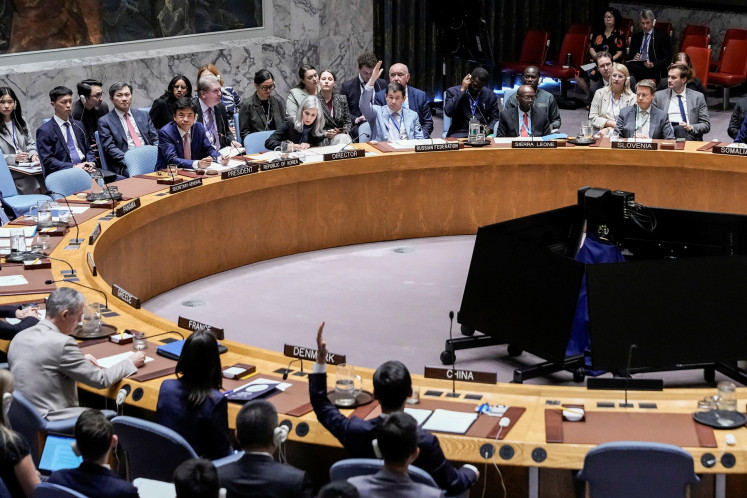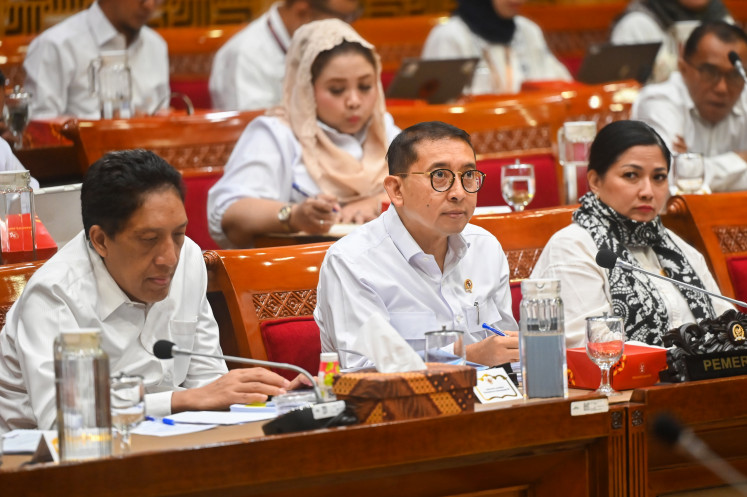Popular Reads
Top Results
Can't find what you're looking for?
View all search resultsPopular Reads
Top Results
Can't find what you're looking for?
View all search resultsAlfira O’Sullivan: Dancing her way home and beyond
Alfira O’Sullivan
Change text size
Gift Premium Articles
to Anyone
A
span class="caption" style="width: 339px;">Alfira O’Sullivan. (JP/Dina Indrasafitri) Australian dancer Alfira O’Sullivan’s love for Indonesian dance has led her to share her moves with audiences across the world, from cosmopolitan Sydney to war-torn Palestine.
The founder of Sydney-based Suara Indonesia dance group has performed in local and international festivals and collaborated with a number of noted artists such as puppeteer Slamet Gundono.
Alfira also performs with the dance group in Australian schools to help students get better acquainted with Indonesia’s cultural heritage. Her workshops often go beyond borders, such as when she taught dances in a refugee camps in Palestine three years ago.
Her passion and curiosity for dance has been fueled partly due to her feeling like an outsider, as an Australian of Indonesian and Irish heritage. When among Indonesians, she is often considered a bule (white person), yet she is also “Asian” in some Caucasian surroundings.
“I think dancing was just one way of finding out more about my Indonesian culture,” Alfira said in an interview late last year.
As the daughter of an Acehnese mother, her childhood was colored with Indonesian customs and food, but most of the time it was no different from those of other Australian children. Her mother and aunt were involved in Indonesian dances in one way or another, but merely as a hobby.
Then when she was 16 years old, Alfira volunteered to teach English in a village in Cilacap, West Java. It was there that she became acquainted with a math teacher who taught her the Yapong dance.
“When I came back, my mom really liked it but she said, ‘The best dance is Acehnese dance so you have to learn that one day,’” she recalled.
And so she did. In fact, she proceeded to learn plenty of other Indonesian dances after deciding to study at the Institute of the Arts (ISI) in Yogyakarta and Surakarta. Acehnese dance, however, became the focus of many of her works.
Alfira decided it was not enough for her to learn the dance from a teacher in Java. In 2006, just one year after the devastating tsunami, she went to Aceh to deepen her knowledge about the dance.
Prior to actually setting foot in the region, she had tried to help tsunami victims from Sydney, by busking with Suara Indonesia in front of the Opera House and the Pitt Street Mall.
Her aim in Aceh had been to teach tsunami and conflict victims the dance with a group of local artists, as part of the victim’s healing process.
Among the local artists she met in Aceh was Murtala, a dancer and choreographer who was passionate about reviving the dance because according to him, many Acehnese artists had left the region for Jakarta due to the decades-long conflict and the imposition of strict curfews.
Alfira was moved by the children’s happiness as they practiced the dances. “I think it’s the process of actually getting the kids together and learning from their teachers. So the teachers kind of become their mentors … when you bring something like a traditional dance back, you’re putting something back in place for your identity,” she said.
Murtala and his local NGO, which was composed mostly of local artists, however, saw more potential in Alfira than just her enthusiasm for dance. As a native English speaker, she became the translator to assist communication between the artists and potential donors.
Acehnese dances have a special place in her heart, mostly because they are an art form that connects her with her roots, but also because they contains philosophical values she agrees with.
“One of the principles of Acehnese dance is to dance as one body and one soul and I really love that. I try to do that with my group so that they don’t lose the essence of the dance. Because we are new to the stage, because we are in an arena of entertainment, because we have to compete on a global stage, a lot can be lost in Acehnese dance. So keeping this kind of roh [soul], if you can keep that, I think we have achieved a lot in the dance, even if not everyone is Muslim. I have devout Christians in my group as well,” Alfira said.
In 2010, she succeeded in sharing her love for the dance with people in Palestine. Her journey there began with the meeting with young Australian filmmaker Fatima Mawas at a conference in Yogyakarta. When Mawas revealed her desire to go to Palestine, Alfira immediately announced that she wanted to accompany her.
Alfira organized the trip herself, contacting art centers and offering to conduct workshops with the locals. She also underwent interrogation and “had to do a lot of smiling” to get through Israeli borders. In the end, however, it was worth it.
“They loved it because the Palestinian people appreciate volunteers coming in all the time. You get people from the West always coming in and when they heard an Australian girl they were thinking, ‘Oh it’s going to be ballet or hip-hop or something,’ so when I talked about folkloric dance from Aceh they couldn’t believe it. They loved it and also, because a lot of the songs were Arabic, they could sing it themselves,” she recalled.
During her time there, Alfira also collaborated with Mawas in making an art film titled Fiddler on the Roof. It depicted Alfira performing an emotional dance involving her scattering handfuls of soil against the background of Bethlehem. The inspiration, she said, came from stories told by locals about people who were taken away and never returned.
“The families wouldn’t see their loved ones for years and [the ones who took the people] would come back and give the families dirt as a symbol to notify that [the ones who were taken] had died in jail,” she said.
Today, Alfira still has many dreams to pursue, with most of them involving her brainchild, Suara Indonesia dance group.
The group was founded in 2001, at first as a hobby. Although it never meant to do so exclusively, Suara Indonesia drew many half-Indonesians to join its activities. So many of the groups’ members were campur (mixed blood Indonesian) youths that Alfira remembered being surprised when a woman asked if her daughter, who was not a campur, could join.
“I think I also attracted people that are similar to me. People that are mixed in their identity..” she said.
Suara Indonesia not only performs in festivals — the group also organizes weddings for Indonesians living in Australia.
The dance group is slated to hold an Indonesian culture and arts bazaar called ASYIK, which means “cool” or “fun”, this June at the Addison Road Community Centre in Marrickville, New South Wales.
The event will feature a performance of the Acehnese dance Ratoh Duek, involving 150 Australian school children from the area. According to Alfira, this will be the most non-Indonesian people performing the dance outside of Indonesia.
Her greatest satisfaction, nevertheless, remains the feeling she got from the groups’ workshops in schools, where their performances are met with the enthusiasm of thousands of children.
According to Alfira, getting young people interested in Indonesia through the teaching of performing arts might help solve problems such as the declining number of Australians studying Indonesian in universities.
“There has been a lot of talk about student numbers in universities. I find that a lot of the dosen [lecturers] are not doing enough on the performing arts of Indonesia, and actually through the performing arts, you can have a huge impact on the kids, which could then feed into high school and universities, so in the end everyone’s happy,” she said, referring to the drop in the number of Australian students studying Indonesia’s language and culture.










